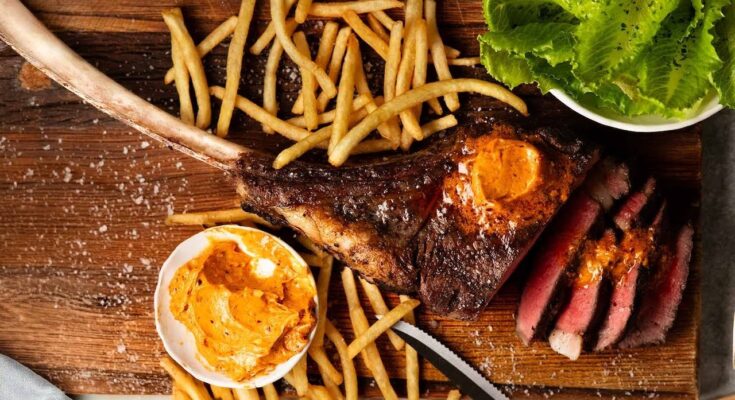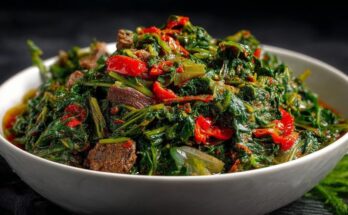Tomahawk Steak Recipe: The Tomahawk steak isn’t just another cut of beef—it’s a culinary showstopper. This impressive piece of meat gets its name from its resemblance to a tomahawk axe, thanks to the long, frenched rib bone still attached. Cut from the rib section of a cow (specifically the ribeye), the Tomahawk steak typically includes five to six inches of bone, creating a dramatic presentation and locking in flavor. Weighing between 30 and 45 ounces, it’s meant for sharing—or satisfying a truly ravenous appetite.
What makes the Tomahawk stand out isn’t just its size or shape—it’s the marbling. This cut is beautifully laced with fat, which melts during cooking to keep the meat juicy and tender. If you’re aiming to impress guests or celebrate a special occasion with a steak that turns heads and delights taste buds, the Tomahawk is your golden ticket.
Why It’s Popular Among Steak Lovers
Steak lovers are always chasing that elusive perfect bite—juicy, tender, and packed with beefy flavor. The Tomahawk delivers all that and more. The attached bone doesn’t just look impressive—it also helps insulate the meat during cooking, making it cook more evenly. When done right, a Tomahawk steak has a rich, smoky crust on the outside and a succulent, medium-rare center.
It’s also popular because it’s a true “event” meal. Cooking a Tomahawk isn’t just about throwing a piece of meat on the grill—it’s a ritual. From seasoning to resting, every step builds anticipation. And when you finally slice into it, you’re rewarded with one of the most flavorful and satisfying steak experiences out there. Whether you’re grilling it over live fire or using the reverse sear method, the process is as exciting as the result.
Ingredients and Tools You’ll Need
Essential Ingredients for a Juicy Tomahawk Steak
You don’t need a laundry list of ingredients to make a great steak. In fact, simplicity is your best friend when it comes to Tomahawk steak. Here’s what you’ll need:
- Tomahawk Steak (2–3 lbs): Choose one with good marbling.
- Kosher Salt: For deep seasoning and crust formation.
- Freshly Ground Black Pepper: Adds a sharp, spicy edge.
- Olive Oil or Avocado Oil: For searing.
- Fresh Herbs (optional): Rosemary or thyme can elevate flavor.
- Garlic Cloves (optional): For aromatics during cooking.
- Butter (optional): Basting during sear adds richness.
That’s it. The goal is to let the quality of the meat shine. A little salt, pepper, and good technique are all it takes.
Recommended Tools for Perfect Cooking
Having the right tools makes a massive difference, especially with a thick cut like the Tomahawk. Here’s your toolkit:
- Meat Thermometer: Absolutely essential to avoid over- or undercooking.
- Cast Iron Skillet or Grill: For searing and flavor.
- Tongs: Long ones help handle the large steak safely.
- Aluminum Foil: To tent the steak while resting.
- Cutting Board and Sharp Knife: For slicing and presentation.
Optional but helpful:
- Chimney Starter and Charcoal (for grill use)
- Oven (if using reverse sear method)
Having these on hand keeps the cooking process smooth and stress-free, ensuring you don’t miss a beat when the heat is on.
Prepping the Tomahawk Steak
Bringing the Steak to Room Temperature
One of the most overlooked but important steps in cooking a perfect Tomahawk steak is allowing it to come to room temperature. Why? Because cooking a cold steak straight from the fridge leads to uneven results. The outside will cook faster while the inside stays raw.
Take the steak out of the refrigerator at least 60 minutes before cooking. Pat it dry with paper towels to remove surface moisture—this step is crucial for that golden crust you’re aiming for during the sear.
As the steak warms up, you’ll also notice the marbling soften slightly, which helps distribute fat more evenly as it cooks. While it’s resting, it’s the perfect time to gather your seasonings and tools so everything’s ready to go once it hits the heat.
Seasoning the Right Way
Don’t be shy when it comes to seasoning. A Tomahawk is a thick cut, and it needs generous flavor on the outside to balance its rich interior. Start with a liberal coating of kosher salt—the coarse grains draw out moisture and help form a crust. Follow with a generous amount of freshly cracked black pepper.
Want to get fancy? Add a bit of garlic powder or smoked paprika for extra depth. If you’re planning to baste later, prepare some butter with crushed garlic and thyme or rosemary—this compound butter will infuse the steak with delicious aromas during the final sear.
Once seasoned, let the steak rest while your grill or oven heats up. This allows the salt to work its magic, and the flavors begin to penetrate.
Cooking Methods Explained
Reverse Sear Method
The reverse sear method is the holy grail for cooking thick steaks like the Tomahawk. This technique flips the traditional method on its head: instead of searing first, you cook the steak low and slow, then finish with a hard sear at the end. This ensures a perfect medium-rare from edge to edge, with a beautiful crust on the outside.
To do this:
- Preheat your oven or grill to 250°F (120°C).
- Cook the steak until it reaches an internal temp of 115°F (46°C) for medium-rare.
- Let it rest for 10 minutes.
- Sear it on a hot skillet or grill for 1–2 minutes per side until the crust is golden brown.
The reverse sear is almost foolproof and ideal for large cuts where you need to control doneness with precision.
Grilling vs. Pan Searing
Both grilling and pan searing have their merits.
Grilling gives your Tomahawk that signature smokiness and gorgeous grill marks. It’s the go-to method for outdoor cooking and adds a layer of flavor that’s hard to replicate indoors. Ideal for warmer months or special events.
Pan searing, on the other hand, offers more control. A cast iron skillet retains heat like a champ and delivers a uniform sear. It’s great for smaller kitchens or when you want to cook indoors.
Either way, the key is high heat for the sear, and precise temp control for the interior. Combine both methods (like in reverse sear), and you get the best of both worlds.
Step-by-Step Cooking Instructions
Step 1: Preheat Your Grill or Oven
The first real action step in cooking your Tomahawk steak begins with heat. Depending on your chosen method—grill, oven, or a combination—you’ll want to get your cooking surface hot and ready before the steak touches it. If you’re going with the reverse sear, preheat your oven to 250°F (120°C) or set your grill for indirect heat at the same temperature.
This low-and-slow phase is critical. It gently cooks the inside of the steak without drying it out, giving you more control over the final doneness. If you’re using a grill, set up a two-zone fire: coals or burners on one side (direct heat) and none on the other (indirect heat). Place the steak on the cooler side to start.
Pro tip: Preheat your cast iron skillet during this stage as well—when it’s time to sear, you’ll want it blazing hot to lock in juices and build that delicious crust.
Step 2: Sear the Steak
Once the internal temperature of your steak hits about 115°F (46°C) for medium-rare, it’s time to bring the heat—literally. Transfer your steak from the oven or indirect heat side of the grill to the hottest surface you have. This is where the magic happens.
Use your cast iron skillet or direct grill flames. Add a splash of high-heat oil like avocado oil to the skillet, and if you’re feeling luxurious, throw in a knob of butter with crushed garlic and herbs for basting.
Sear each side of the steak for 1.5 to 2 minutes, flipping only once to avoid overcooking. Don’t forget the sides and the fat cap—use tongs to hold the steak upright and sear all around. The goal here is to build that irresistible caramelized crust that steak lovers crave.
Step 3: Slow Cook to Desired Temperature
If you’re using the reverse sear method, you’ve already slow-cooked your steak before searing. But if you started with a traditional high-heat sear, now is the time to move it to the indirect side of the grill or place it in a 350°F (175°C) oven to finish cooking gently.
Use a meat thermometer to monitor the internal temperature closely:
- Rare: 120–125°F (49–52°C)
- Medium Rare: 130–135°F (54–57°C)
- Medium: 140–145°F (60–63°C)
- Medium Well: 150–155°F (65–68°C)
Remember: the steak will continue to rise in temperature by 5°F while it rests, so plan accordingly. Precision here is the key to that perfect pink center.
Step 4: Rest and Serve
This is the final step—and arguably one of the most important. Once your steak hits the desired internal temperature, remove it from heat and let it rest for at least 10 to 15 minutes. This isn’t just about cooling down—it’s about flavor and juiciness.
Resting allows the juices that have been driven to the center of the steak during cooking to redistribute throughout the meat. If you cut too soon, all those savory juices will spill onto your cutting board instead of staying inside the steak.
Tent it loosely with aluminum foil and resist the urge to slice. When you do finally carve it, slice against the grain in thick, satisfying cuts. Serve with a side of roasted vegetables, mashed potatoes, or even a bold chimichurri sauce to elevate your steak night.
How to Carve and Present a Tomahawk Steak
Once your steak is rested, carving it properly ensures each bite is as delicious as it should be. Start by cutting along the bone to remove it cleanly. Then, turn the meat and slice it into thick strips—about half an inch wide—against the grain.
Presentation matters. Lay the slices back along the bone on a wooden board or platter for a dramatic, restaurant-style look. Garnish with a sprinkle of flaky sea salt, fresh herbs, or a squeeze of lemon for brightness. Serve with your favorite sauce on the side or let the meat speak for itself.
This is a showpiece steak, so embrace the theater of the moment—cut it tableside and enjoy the “wow” reactions from your guests.
Tips for Cooking the Perfect Tomahawk Steak
Choosing the Right Cut
Not all Tomahawk steaks are created equal. When shopping for your steak, choose a cut that has:
- Plentiful marbling: These streaks of fat are the secret to flavor and tenderness.
- Bright red color: Indicates freshness and quality.
- Dry surface: Moist cuts may have been frozen or poorly stored.
Go to a reputable butcher or high-end grocery store. Look for USDA Prime or Choice grades in the U.S., or similar high-quality grading if you’re abroad. The bone should be cleanly frenched (exposed), giving that signature tomahawk axe look.
If possible, ask your butcher to dry-age the steak for you. Dry aging intensifies flavor and makes the meat more tender.
Letting the Steak Rest After Cooking
Yes, we covered this briefly—but it’s so critical that it deserves its own section. The resting phase is non-negotiable. If you’ve ever cut into a steak and watched juice flood the plate, you’ve learned this the hard way.
Here’s the science: as meat cooks, its juices are forced toward the center. Resting gives those juices time to redistribute evenly, resulting in each bite being juicy and full of flavor. The fibers in the meat also relax, making the steak more tender.
Tent your steak with foil, don’t wrap it tightly. Let it sit for at least 10 minutes, up to 15 for thicker cuts. Use that time to plate your sides, warm your sauce, or pour yourself a well-earned drink.
Avoiding Common Mistakes
Even experienced grill masters can trip up when handling a tomahawk. Here are the top mistakes to avoid:
- Skipping the thermometer: Don’t guess—use a digital meat thermometer.
- Under-seasoning: This is a large piece of meat. Salt generously!
- Not drying the surface: Moisture prevents that golden crust from forming.
- Cooking it cold: Always let your steak reach room temperature first.
- Cutting too soon: You’ll lose juices and flavor.
Cook with intention, stay patient, and follow each step with care. The result will be a steak worth savoring.
Serving Suggestions and Side Dishes
Perfect Pairings for Tomahawk Steak
What do you serve with a steak this epic? You need sides that complement, not compete. Here are some all-star pairings:
- Garlic mashed potatoes: Creamy and smooth, the ultimate comfort food.
- Grilled asparagus or green beans: Adds freshness and crunch.
- Roasted mushrooms: Earthy and rich, they bring out the meat’s depth.
- Caesar or wedge salad: Offers a cool, crisp contrast.
Add a simple sauce like:
- Chimichurri for herby brightness.
- Red wine reduction for elegance.
- Compound butter with garlic and herbs for richness.
Don’t forget the drink! A bold red wine like Cabernet Sauvignon or Malbec pairs beautifully. For beer lovers, a strong IPA or stout adds a nice bite.
Tomahawk Steak for Special Occasions
There’s something celebratory about a Tomahawk steak. It turns a regular dinner into a memorable event—perfect for:
- Anniversaries
- Father’s Day
- Birthday feasts
- Holiday barbecues
- Graduation dinners
Its size and presentation make it the ideal centerpiece. Set the scene with candles, music, or an outdoor setting. Even the act of slicing and serving becomes an experience. When cooked right, a Tomahawk steak delivers flavor, drama, and satisfaction in every bite.
FAQs about Tomahawk Steak Recipe
1. What is the best way to cook a Tomahawk steak?
The best method is the reverse sear—slow-cook it in the oven or over indirect grill heat, then finish with a high-heat sear for a crusty exterior and juicy inside.
2. How long should a Tomahawk steak rest?
Let it rest for 10 to 15 minutes after cooking to allow juices to redistribute and prevent them from running out when sliced.
3. What internal temperature is ideal for medium-rare?
For medium-rare, aim for an internal temperature of 130–135°F (54–57°C). Use a meat thermometer for accuracy.
4. Can I cook a Tomahawk steak in the oven only?
Yes, but for the best crust, sear it in a cast iron skillet after baking. This combo gives you the best texture and flavor.
5. How many people does one Tomahawk steak serve?
Typically, a Tomahawk steak weighing 2–3 lbs can comfortably serve 2–3 people, depending on appetite and side dishes.
Conclusion
Cooking a Tomahawk steak isn’t just about food—it’s about creating an experience. From selecting a prime cut to carefully prepping and reverse searing, every step builds toward that unforgettable first bite. You don’t need fancy marinades or complicated ingredients—just quality meat, heat control, and a little patience.
Whether you’re hosting a dinner party, celebrating a milestone, or just craving the best steak of your life, the Tomahawk delivers every time. With this step-by-step guide, you’ve got all the tools to turn your kitchen into a five-star steakhouse. So fire up that grill, grab your tongs, and let’s make magic happen—one juicy slice at a time.



